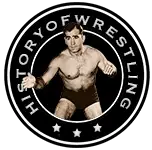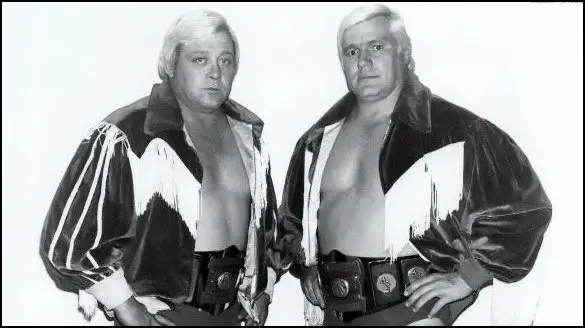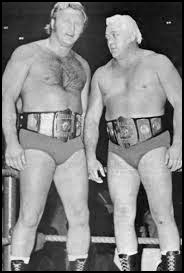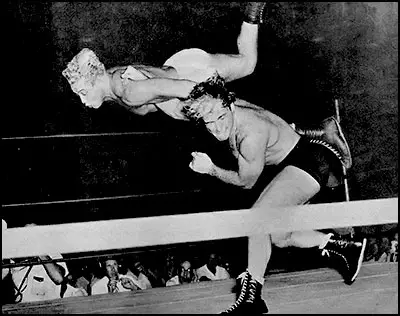by Stephen Von Slagle
No matter the era, passionate wrestling fans have always enjoyed debating over which athlete is the “greatest professional wrestler of all time.” Generally speaking, it’s a fruitless argument but a fun pastime, nevertheless. One wrestler who, according to virtually every wrestler who ever worked with him, could truly lay claim to this distinction would be the incredibly gifted, multi-talented Ray “The Crippler” Stevens. However, perhaps because he never won the World title and he wrestled during an era long since passed, Stevens is often overlooked during discussions of wrestling’s greatest stars. Notwithstanding his lack of notoriety amongst current followers of the sport, the fact remains that “The Crippler” set a standard of believability and athleticism inside of the ring that few were able to match. Without question, Stevens is one of the most influential and important wrestlers in the history of professional wrestling.
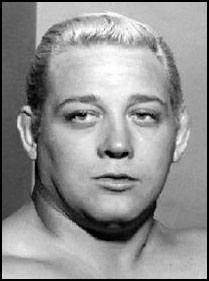 Ray Stevens was born Carl Stevens on September 6, 1935 and grew up in the Columbus, Ohio area. His calling in life came early on and he began his pro wrestling career in 1951 when he was just fifteen years old. Although his natural talent was evident to matchmakers from the start, the young grappler took the traditional route of a pro wrestler in that day and began at the bottom of the card. Within a few years, though, the young “Blond Bomber” was on the fast track to pro wrestling stardom. One of his first championships came on May 2, 1956 when he teamed with Don Stevens (Don Fargo) to win the Ohio Tag Team title. Although their reign was brief, the Stevens Brothers were a very successful duo and an important early chapter in Ray Stevens’ young career. A 21 year-old Stevens went on to capture the regionally prestigious M.W.A. World Junior Heavyweight title on June 14, 1956 in Columbus, Ohio and he also became the inaugural NWA Florida TV champ on November 21, 1956. He followed that championship victory a year later when he won the NWA Southern Jr. Heavyweight title on November 11, 1957 in Birmingham, Alabama. The talented young Stevens held the belt for nearly a half year before losing it back to the man he won it from, Japanese powerhouse Tor Kamata. In all, Stevens enjoyed three reigns as the NWA Southern Jr. Heavyweight champion during the late Fifties and by the time he was just twenty years old he’d become a seasoned worker and a credible champion. The experience he accumulated in those five years and the championship belts he’d earned helped prepare Stevens for even bigger things still to come.
Ray Stevens was born Carl Stevens on September 6, 1935 and grew up in the Columbus, Ohio area. His calling in life came early on and he began his pro wrestling career in 1951 when he was just fifteen years old. Although his natural talent was evident to matchmakers from the start, the young grappler took the traditional route of a pro wrestler in that day and began at the bottom of the card. Within a few years, though, the young “Blond Bomber” was on the fast track to pro wrestling stardom. One of his first championships came on May 2, 1956 when he teamed with Don Stevens (Don Fargo) to win the Ohio Tag Team title. Although their reign was brief, the Stevens Brothers were a very successful duo and an important early chapter in Ray Stevens’ young career. A 21 year-old Stevens went on to capture the regionally prestigious M.W.A. World Junior Heavyweight title on June 14, 1956 in Columbus, Ohio and he also became the inaugural NWA Florida TV champ on November 21, 1956. He followed that championship victory a year later when he won the NWA Southern Jr. Heavyweight title on November 11, 1957 in Birmingham, Alabama. The talented young Stevens held the belt for nearly a half year before losing it back to the man he won it from, Japanese powerhouse Tor Kamata. In all, Stevens enjoyed three reigns as the NWA Southern Jr. Heavyweight champion during the late Fifties and by the time he was just twenty years old he’d become a seasoned worker and a credible champion. The experience he accumulated in those five years and the championship belts he’d earned helped prepare Stevens for even bigger things still to come.
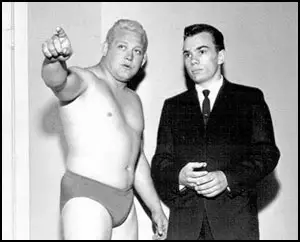 A truly life-changing event took place when Stevens formed a team with Roy Shire and began appearing as his younger “brother” Ray Shire. On August 6, 1959, the Shire Brothers won the Chicago version of the NWA World Tag Team championship from Dick the Bruiser and Angelo Poffo. Approximately a year later, The Shires regained the World Tag Team title, this time besting Dick the Bruiser and Gene Kiniski, further establishing themselves as one of the best teams in professional wrestling. When his “brother” Roy Shire became the owner of the San Francisco territory, Stevens moved his base of operations to the west coast, specifically San Francisco. Soon after entering the territory, Stevens became the first United States Heavyweight champion (San Francisco version) in November of 1960. In all, he won the United States title, the region’s top championship, seven times between 1960-1968 and established himself as the talent-rich territory’s biggest star. Whether performing as a beloved babyface or a hated heel, Stevens’ natural charisma and in-ring talent always kept his audience enthralled and his record of sell-outs at The Cow Palace in San Francisco was truly impressive. Meanwhile, behind the scenes, he was a teacher and locker room leader in the Northern California territory, not to mention being promoter Roy Shire’s go-to man. With the superlatively talented Stevens there to execute his notoriously complex finishes and storylines, the detail-orientated Shire molded the San Francisco territory into one of the most successful and respected promotions in the country during the Sixties and into the Seventies. By 1969, Shire’s territory had joined the National Wrestling Alliance and the NWA began recognizing what had been its United States championship. Stevens wore the NWA United States title twice, thus making him a nine time U.S. champ and, by far, the most dominant titleholder in the once prestigious championship’s twenty-year history.
A truly life-changing event took place when Stevens formed a team with Roy Shire and began appearing as his younger “brother” Ray Shire. On August 6, 1959, the Shire Brothers won the Chicago version of the NWA World Tag Team championship from Dick the Bruiser and Angelo Poffo. Approximately a year later, The Shires regained the World Tag Team title, this time besting Dick the Bruiser and Gene Kiniski, further establishing themselves as one of the best teams in professional wrestling. When his “brother” Roy Shire became the owner of the San Francisco territory, Stevens moved his base of operations to the west coast, specifically San Francisco. Soon after entering the territory, Stevens became the first United States Heavyweight champion (San Francisco version) in November of 1960. In all, he won the United States title, the region’s top championship, seven times between 1960-1968 and established himself as the talent-rich territory’s biggest star. Whether performing as a beloved babyface or a hated heel, Stevens’ natural charisma and in-ring talent always kept his audience enthralled and his record of sell-outs at The Cow Palace in San Francisco was truly impressive. Meanwhile, behind the scenes, he was a teacher and locker room leader in the Northern California territory, not to mention being promoter Roy Shire’s go-to man. With the superlatively talented Stevens there to execute his notoriously complex finishes and storylines, the detail-orientated Shire molded the San Francisco territory into one of the most successful and respected promotions in the country during the Sixties and into the Seventies. By 1969, Shire’s territory had joined the National Wrestling Alliance and the NWA began recognizing what had been its United States championship. Stevens wore the NWA United States title twice, thus making him a nine time U.S. champ and, by far, the most dominant titleholder in the once prestigious championship’s twenty-year history.
However, in between his numerous reigns as the United States champion during the Sixties, Stevens also picked up several other prominent titles. For instance, along with former enemy-turned-partner Pat Patterson, Stevens captured the AWA World Tag Team championship (later renamed the NWA World Tag Team championship) twice between 1965-1967, holding the belts for a total of twelve months. Another title that added greatly to his credibility as a top wrestler was the IWA World Heavyweight championship, which he also won twice. The IWA belt was a respected World title that was recognized in Australia, New Zealand and other parts of the Southern hemisphere. In 1965, Stevens travelled “down under” and defeated Dominic Denucci in Sydney, Australia to win the continent’s World title. After losing the title back to Denucci, Stevens then regained the World championship on December 2, 1966 when he defeated Spiros Arion, again in Sydney. Additionally, “The Crippler” also wore the Hawaiian version of the NWA U.S. Title (later renamed the NWA North American title) in May of 1968.
But, with the decade of the Seventies came new challenges for Stevens. After dominating the West Coast for over ten years, and having established himself as one of the elite champions of the day, Stevens moved on to other regions within the territorial structure of the time, namely the AWA. Along the way, the perennial champion also formed what would eventually become one of the greatest tag teams in wrestling history when he teamed with the up and coming, second-generation star Nick Bockwinkel. A duo that combined speed, skill, teamwork and experience, Stevens & Bockwinkel immediately gelled, quickly amassing an impressive championship resume together. Their first title came in the form of the AWA World Tag Team championship, which they won on January 20, 1972 by defeating Verne Gagne & Billy Robinson. From there, the reigning AWA champions travelled to the heart of NWA territory and scored the Florida Tag championship, which they won on July 20, 1972 by defeating Hiro Matsuda & Tim “Mr. Wrestling” Woods in Tampa. While their run as the Florida champions lasted just a month, the point had been made; Stevens & Bockwinkel were a team to be reckoned with. Back in the AWA, the duo continued their lengthy reign until they were finally beaten on December 30, 1972 by the team they had originally defeated to win the championship nearly a year earlier, the pairing of Verne Gagne & Billy Robinson. Less than two weeks later, though, Stevens & Bockwinkel, led by their controversial manager Bobby “The Brain” Heenan, were once again in possession of the AWA title belts, as they defeated Gagne & Robinson in a rematch on January 6, 1973.
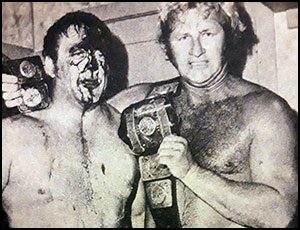 Over the course of the following year and a half, Heenan’s duo ruled over the competitive AWA tag team ranks and, by hook or crook, dominated their opposition like few other teams in the history of the multi-state territory. Eventually, though, the team met their match on July 21, 1974 when they were defeated by the duo of The Crusher & Billy Robinson. Stevens & Bockwinkel’s third and final reign as the AWA World Tag Team champions came on October 24, 1974 when they regained the title from Crusher & Robinson in Winnipeg. From there, they carried the championship belts for another ten months until they were defeated on August 16, 1975 by the legendary team of Dick the Bruiser & The Crusher in Chicago, Illinois. In the months following their final title loss, the longtime teammates had a falling out and worked a very successful program against each other, with Stevens being the recipient of the fans’ support in the feud. However, despite the fact that their feud was both lengthy and intense, Stevens & Bockwinkel will be remembered not as bitter enemies, but rather, as the most successful heel duo in AWA tag team history. In all, the team held the AWA World Tag Team title for over three years during the decade of the Seventies, making them the longest reigning tag team champions in the thirty-one year history of the promotion. Several years later, Stevens again became an AWA World Tag Team champion when he and his other longtime partner, Pat Patterson, reformed the team that had been so successful in San Francisco years earlier. Stevens & Patterson, The Blond Bombers, went on to hold the prestigious tag team title for nearly a full year before losing the straps to Verne Gagne & Mad Dog Vachon in 1979.
Over the course of the following year and a half, Heenan’s duo ruled over the competitive AWA tag team ranks and, by hook or crook, dominated their opposition like few other teams in the history of the multi-state territory. Eventually, though, the team met their match on July 21, 1974 when they were defeated by the duo of The Crusher & Billy Robinson. Stevens & Bockwinkel’s third and final reign as the AWA World Tag Team champions came on October 24, 1974 when they regained the title from Crusher & Robinson in Winnipeg. From there, they carried the championship belts for another ten months until they were defeated on August 16, 1975 by the legendary team of Dick the Bruiser & The Crusher in Chicago, Illinois. In the months following their final title loss, the longtime teammates had a falling out and worked a very successful program against each other, with Stevens being the recipient of the fans’ support in the feud. However, despite the fact that their feud was both lengthy and intense, Stevens & Bockwinkel will be remembered not as bitter enemies, but rather, as the most successful heel duo in AWA tag team history. In all, the team held the AWA World Tag Team title for over three years during the decade of the Seventies, making them the longest reigning tag team champions in the thirty-one year history of the promotion. Several years later, Stevens again became an AWA World Tag Team champion when he and his other longtime partner, Pat Patterson, reformed the team that had been so successful in San Francisco years earlier. Stevens & Patterson, The Blond Bombers, went on to hold the prestigious tag team title for nearly a full year before losing the straps to Verne Gagne & Mad Dog Vachon in 1979.
As the Eighties rolled in, Stevens continued to enjoy a highly successful run in the NWA’s Mid Atlantic territory, and on March 29, 1980 he captured the NWA World Tag Team title with partner Greg “The Hammer” Valentine. The Crippler and The Hammer were a tough combo, indeed, and they dominated their Mid Atlantic competition. That is, until they came up against the young and incredibly popular team of Ricky Steamboat & Jay Youngblood. Stevens and Valentine were defeated in April of 1980, ending their championship run. However, under the managerial leadership of Gene Anderson, Stevens immediately came back to challenge the team of Steamboat & Youngblood, this time with fellow Anderson stablemate Jimmy “Superfly” Snuka. The Crippler got his revenge against his young foes on June, 22, 1980 when he and Snuka captured the prized title belts. Anderson’s men formed a highly dominant, vicious rule breaking team that ruled over the talent-rich NWA territory’s tag division for a full half-year before finally dropping the straps to The Masked Superstar & Paul Jones in Greensboro, North Carolina. Two months later, Stevens regained his World title from Jones & The Superstar, enlisting the aid of the mighty “Russian Bear” Ivan Koloff this time around.
Next up for “The Crippler” was a trip to the Northeast, wrestling for the McMahon family’s lucrative World Wrestling Federation just prior to the regional group’s national expansion. Under the managerial guidance of the infamous Captain Lou Albano, Stevens was a major part of several key WWF storylines during the early Eighties and he enjoyed a great deal of success during his time in the Federation. Following a babyface turn, Stevens transitioned from the ring to the announcer’s booth, briefly doing color commentary alongside Vince McMahon in 1984. Before long, though, it was time for “The Crippler” to find his next challenge. The nomadic Stevens once again packed up and moved on to another territory, this time landing back in Verne Gagne’s American Wrestling Association. Despite his advancing age, the thirty-year veteran was still more than capable of handling himself in the ring and he enjoyed a good deal of success both in the singles and tag ranks following his return to the AWA. However, he soon picked up where he’d left off in the WWF and continued making the transition from active wrestler to color commentator. By the end of the decade, Stevens had retired and become a prominent member of the announce team for the AWA’s ESPN show, as well as its syndicated programs. When the American Wrestling Association ceased operations in 1992, Ray “The Crippler” Stevens permanently retired from professional wrestling after some forty years in the business.
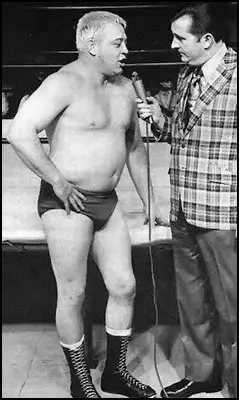 Although he is widely recognized as arguably the most talented performer of his era and a perennial champion, the fact remains that Stevens never wore the premier title of the day, the NWA World Heavyweight championship. Granted, he did wear multiple versions of the World title, but never the Big One, and the reason for that can be traced not to Stevens’ ability in the ring or his mic skills. The true reason he was passed over as a potential NWA champion probably had a lot more to do with who Ray Stevens was as a person. A man who truly loved living life to its fullest, Stevens was well-known for his love of racing (and oftentimes, crashing) cars, snowmobiles, motorcycles, boats and anything else that he could drive very, very fast. It was also no secret that he enjoyed the nightlife, and stories of Stevens’ extracurricular activities are legendary. “The Crippler’s” out-of-the-ring escapades had everything to do with having fun, but nothing to do with travelling the globe and defending the World Heavyweight title. Since placing the NWA title on a wrestler was by no means an easy task, the various promoters who selected the titleholder were very cautious when it came to crowning a new champion. Even the slightest hint of unreliability was enough to keep a potential champion from winning the title. While he no doubt had the talent and ability to become a great NWA World champion, his legendary love for having a good time was also the biggest factor in keeping him from an otherwise highly probable run with the World title.
Although he is widely recognized as arguably the most talented performer of his era and a perennial champion, the fact remains that Stevens never wore the premier title of the day, the NWA World Heavyweight championship. Granted, he did wear multiple versions of the World title, but never the Big One, and the reason for that can be traced not to Stevens’ ability in the ring or his mic skills. The true reason he was passed over as a potential NWA champion probably had a lot more to do with who Ray Stevens was as a person. A man who truly loved living life to its fullest, Stevens was well-known for his love of racing (and oftentimes, crashing) cars, snowmobiles, motorcycles, boats and anything else that he could drive very, very fast. It was also no secret that he enjoyed the nightlife, and stories of Stevens’ extracurricular activities are legendary. “The Crippler’s” out-of-the-ring escapades had everything to do with having fun, but nothing to do with travelling the globe and defending the World Heavyweight title. Since placing the NWA title on a wrestler was by no means an easy task, the various promoters who selected the titleholder were very cautious when it came to crowning a new champion. Even the slightest hint of unreliability was enough to keep a potential champion from winning the title. While he no doubt had the talent and ability to become a great NWA World champion, his legendary love for having a good time was also the biggest factor in keeping him from an otherwise highly probable run with the World title.
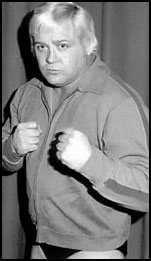 In 1995, the Mayors of both San Francisco and neighboring Oakland, the sites of his greatest triumphs, jointly proclaimed April 5th to be “Ray Stevens Day,” an unprecedented honor. Additionally, he won Pro Wrestling Illustrated’s Tag Team of the Year award twice, with Nick Bockwinkel (1973) and Jimmy Snuka (1980) and he is a member of the Wrestling Observer Newsletter Hall of Fame (1996), the Professional Wrestling Hall of Fame (2006), and the NWA Hall of Fame (2013).
In 1995, the Mayors of both San Francisco and neighboring Oakland, the sites of his greatest triumphs, jointly proclaimed April 5th to be “Ray Stevens Day,” an unprecedented honor. Additionally, he won Pro Wrestling Illustrated’s Tag Team of the Year award twice, with Nick Bockwinkel (1973) and Jimmy Snuka (1980) and he is a member of the Wrestling Observer Newsletter Hall of Fame (1996), the Professional Wrestling Hall of Fame (2006), and the NWA Hall of Fame (2013).
On May 3, 1996, Ray Stevens passed away following a heart attack at the age of 60.
